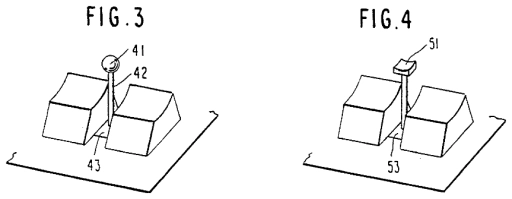Lexmark-Unicomp FSR pointing stick
- Updated
Contents
Background

The Lexmark-Unicomp FSR pointing stick is the force-sensitive resistor based non-isometric pointing stick known for being employed on most Unicomp keyboards with a TrackPoint-style pointing stick as well as some Lexmark-OEM keyboards that were self-branded or made for companies other than IBM. Technically speaking, the technology originated from the same patent that spawned the traditional strain gauge-based TrackPoints as but it provides a vastly different user experience yet is still fundamentally a pointing stick that emanates from in between the G, H and B keys.
Design
As aforementioned, the technology employed is force-sensitive (or force-sensing) resistor (FSR) based. FSRs are a much newer technology than strain gauges, with FSRs being invented by Franklin Eventoff in 1977 and strain gauges being invented by Edward E. Simmons and Arthur C. Ruge in 19381. FSRs are comprised of a sensor that has a material whose resistance changes when force is applied to it2.
Like TrackPoint II, the implementation of this originated from Lexmark's November 1990's patent US5521596A that was in Unicomp's hands from March 1997 until it expired. Whilst that Lexmark patent primarily discusses the pointing stick being used with strain gauges, the door is left open for other technologies to be used. The patent gives a piezo-electric, piezo-resistive, resistive fluid, magnetic reluctance, variable inductance and variable capacitance sensors as examples of alternative technologies that could be used for the pointing stick. The piezo-resistive sensor seems to be the part of the patent they utilise (along with its given form) as it describes a sensor that can measure a change in resistance when the pointing device is used3.

There is no indication that the Lexmark-Unicomp FSR design was altered or enhanced during its lifetime. Thus, it is important to note that these pointing sticks do not utilise features described in IBM's subsequent (to US5521596A) TrackPoint patents such as the negative inertia transfer function from 1994's patent US5570111A4 and press-to-select via virtual Z-axis measurement5.
Implementation
To summarise what was described above, the three principle differences between Lexmark-Unicomp's pointing stick compared to current TrackPoint IV are the fact it is non-isometric, does not have a negative inertia transfer function written in its firmware, nor can perform actions via a virtual Z-axis. The first difference makes the largest difference to the user experience since the pointing stick acts like a little joystick instead of a stationary stick. In theory, this may appear like a more natural experience for anyone who is not used to TrackPoints, but the close proximity of the keycaps around the pointing stick hampers its acceleration in the up-left, up-right and down directions since the G, H and B key are blocking them respectively.
In ideal conditions (that can be achieved by removing the pointing stick's adjacent keycaps), the lack of negative inertia transfer function leads the stick to perform similarly to TrackPoint II. The function's intent is to counteract the general feeling of sluggishness (ie, having inertia) via acceleration4, so this being absent leads to less acceleration compared to current TrackPoint IV pointing sticks.
- None
